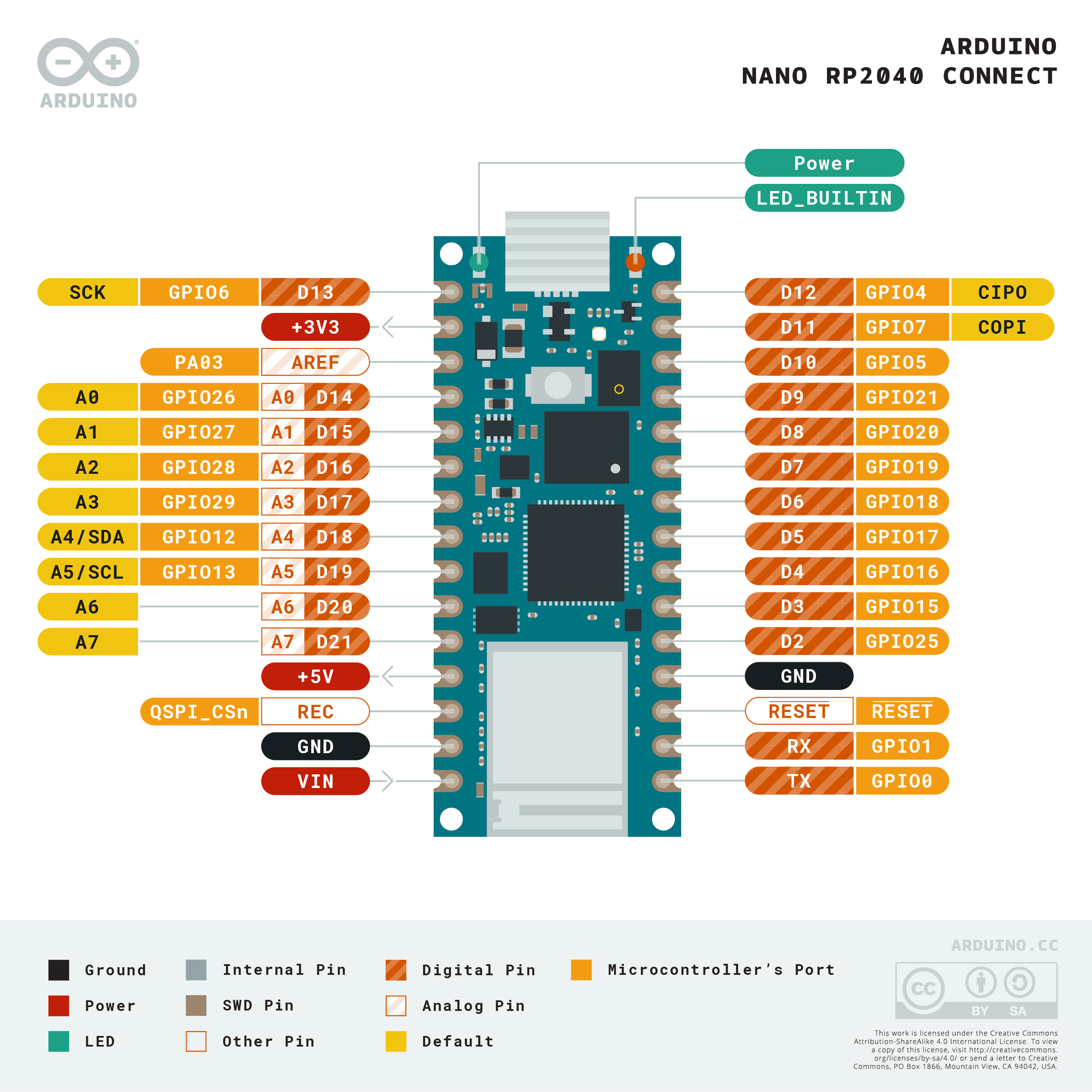The Nano RP2040 Connect fits the Arduino Nano form factor.
The microcontroller for this board is the Raspberry Pi RP2040; which is a dual-core Arm Cortex M0+ running at 133MHz. It has 264KB of SRAM, and the 16MB of flash memory is off-chip to give you extra storage.
Now out of the box the originally Raspberry Pi Pico board had no wifi or bluetooth functionality without an add-on board, this was subsequently rectified by the Pico W which added wifi and also potential bluetooth support which was not enabled at release.
This board came in at £4 and £6 roughly for both versions. This also launched many other boards that used the Rp2040 microcontroller. Arduino then released the Nano RP2040 Connect which also supports Wifi and Bluetooth and has a few other bells and whistles but comes in at around £33.
It has a 6 Axis IMU sensor, a Cryptographic Co-Processor, a MEMs microphone and an RGB led. So although slightly more costly, you can see there are a few added extras on this board. The IMU for example costs around £5 and means you can use this board for a few applications out of the box such as pedometer, step detector and step counter
Features
- Raspberry Pi RP2040 Microcontroller
- 133MHz 32bit Dual Core Arm® Cortex®-M0+
- 264kB on-chip SRAM
- Direct Memory Access (DMA) controller
- Support for up to 16MB of off-chip Flash memory via dedicated QSPI bus
- USB 1.1 controller and PHY, with host and device support
- 8 PIO state machines
- Programmable IO (PIO) for extended peripheral support
- 4 channel ADC with internal temperature sensor, 0.5 MSa/s, 12-bit conversion
- SWD Debugging
- 2 on-chip PLLs to generate USB and core clock
- Multiple low power mode support
- USB 1.1 Host/Device
- Internal Voltage Regulator to supply the core voltage
- Advanced High-performance Bus (AHB)/Advanced Peripheral Bus (APB)
- U-blox® Nina W102 WiFi/Bluetooth Module
- 240MHz 32bit Dual Core Xtensa LX6
- 520kB on-chip SRAM
- 448 Kbyte ROM for booting and core functions
- 16 Mbit FLASH for code storage including hardware encryption to protect programs and data
- 1 kbit EFUSE (non-erasable memory) for MAC addresses, module configuration, FlashEncryption, and Chip-ID
- IEEE 802.11b/g/n single-band 2.4 GHz WiFi operation
- Bluetooth 4.2
- Integrated Planar Inverted-F Antenna (PIFA)
- 4x 12-bit ADC
- 3x I2C, SDIO, CAN, QSPI
- Memory
- AT25SF128A 16MB NOR Flash
- QSPI data transfer rate up to 532Mbps
- 100K program/erase cycles
- ST LSM6DSOXTR 6-axis IMU
- 3D Gyroscope (±2/±4/±8/±16 g full scale)
- 3D Accelerometer (±125/±250/±500/±1000/±2000 dps full scale)
- Advanced pedometer, step detector and step counter
- Significant Motion Detection, Tilt detection
- Standard interrupts: free-fall, wakeup, 6D/4D orientation, click and double-click
- Programmable finite state machine: accelerometer, gyroscope and external sensors
- Machine Learning Core
- Embedded temperature sensor
- ST MP34DT06JTR MEMS Microphone
- AOP = 122.5 dBSPL
- 64 dB signal-to-noise ratio
- Omnidirectional sensitivity
- -26 dBFS ± 1 dB sensitivity
- RGB LED
- Common Anode
- Connected to U-blox® Nina W102 GPIO
- Microchip® ATECC608A Crypto
- Cryptographic Co-Processor with Secure Hardware-Based Key Storage
- I2C, SWI
- Hardware Support for Symmetric Algorithms:
- SHA-256 & HMAC Hash including off-chip context save/restore
- AES-128: Encrypt/Decrypt, Galois Field Multiply for GCM
- Internal High-Quality NIST SP 800-90A/B/C Random Number Generator (RNG)
- Secure Boot Support:
- Full ECDSA code signature validation, optional stored digest/signature
- Optional communication key disablement prior to secure boot
- Encryption/Authentication for messages to prevent onboard attacks
- I/O
- 14 x Digital Pin
- 8 x Analog Pin
- Micro USB
- UART, SPI, I2C Support
About
The operating voltage for Nano RP2040 Connect is 3.3V
All pins except for A6 and A7 are available for PWM.
The RGB LEDs are connected through the Wi-Fi module, so it is required to use the WiFiNINA library to use it.


